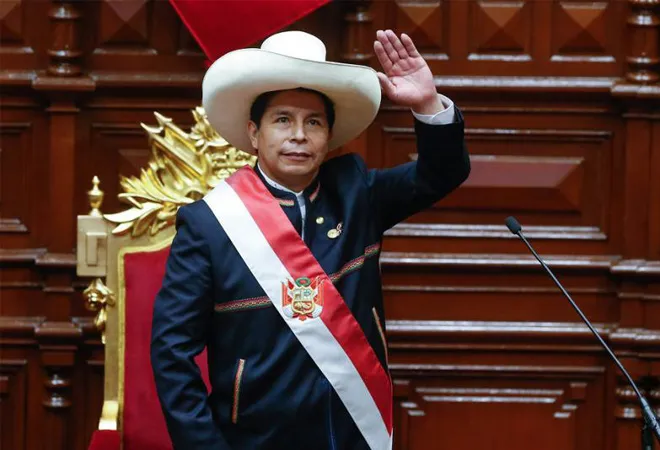
It was only a matter of time until Peru’s Pedro Castillo was impeached as president. Castillo had been hanging by a thread ever since he began his term with a razor-thin 0.2 percent margin in the 2021 elections. Lima’s political elite publicly expressed their distaste for Castillo even before he began his term, and Peru’s Congress began impeachment proceedings soon after he took office. In this context, it’s remarkable that Castillo survived nearly 500 days in office. Castillo’s attempt to dissolve Congress and assume more powers may well be called a ‘self-coup,’ but in reality, it was little more than political suicide. Without the support of his own party or ministers, the armed forces or judiciary, Castillo’s plan was never going to amount to anything more than a self-goal.
As a schoolteacher from Peru’s rural highlands, Castillo had no great ambitions nor a thirst for absolute power. The corruption allegations against Castillo are likely true, but his biggest crime is that he is a political novice, unequipped to navigate Peru’s cunning Congress, let alone run an entire country. Castillo now joins a long line of Peruvian presidents accused of corruption and will spend months in pre-trial detention, alongside the infamous ex-president Alberto Fujimori. Unfortunately, Peru’s new president Dina Boluarte now inherits a tinderbox of a country, with increasingly violent protests that have forced her to declare a nationwide state of emergency.
The corruption allegations against Castillo are likely true, but his biggest crime is that he is a political novice, unequipped to navigate Peru’s cunning Congress, let alone run an entire country.
Castillo is only the tip of the iceberg. Peru’s myriad political crises are the result of the breakdown of political party systems, the showdown between presidents and Congress, and absolute contempt against the entire political class that most Peruvians view as corrupt. Each of these three issues plays a part in creating Peru’s perilous ‘impeachment trap,’ the underlying reason Peru shuffled through six presidents in five years.
Peru’s ‘impeachment trap’ began with the breakdown of political parties in the 1990s under Alberto Fujimori, who severely weakened democratic institutions and parties, particularly the Peruvian APRA Party and Popular Action. Fujimori removed checks and balances vital for democracies. He changed Peru’s legislature from a bicameral Chamber of Deputies and Senate, which governed the country since 1828, to a unicameral Congress that he could easily control. Today, most Peruvian political parties are founded on a cult of personality rather than beliefs and policy positions that resonate with the public.
The constant discord between the country’s executive and legislative branches is the second element of Peru’s ‘impeachment trap.’ In the 21st century, no Peruvian president has held a majority in Congress; few have managed even one-third of Congressional seats. Only 52 votes from the 130-seat Congress are required to begin the impeachment proceedings, and a two-thirds majority can remove the president even on ambiguous grounds like “moral incapacity.” All of Peru’s presidents since 2016 have faced an uphill battle against the Congress, which many Peruvians view as even more corrupt than the country’s presidents.
The final element of Peru’s ‘impeachment trap’ is the near-total contempt of Peru’s political class. The sheer level of disapproval of the political class is unmatched in the history of electoral democracy across the world. Two recent data points confirm this: In Peru’s April 2021 elections, blank and null votes (often seen as ‘protest’ votes) exceeded those received by any single candidate. In a more recent poll, when asked who could be Peru’s next president, a whopping 50 percent said ‘no one’ or ‘I don’t know.’ The top two candidates in the poll were extremists from the right and left, both with under 10 percent approval. The vast unpopularity of Peruvian presidents makes it far more palatable for Congress to impeach their leaders.
If Peruvians are to escape this ‘impeachment trap,’ they must enact certain reforms. First, Peru needs stronger political parties. Electoral reforms can incentivise Peruvians to build and sustain political parties founded on certain beliefs rather than centered on one person. Second, Peru must reinstate a bicameral legislature with a Senate and Chamber of Deputies and remove the ‘moral incapacity’ clause to impeach presidents; this will reduce the friction between the executive and legislature. Yet, it remains unlikely that Boluarte, or her successors, would have the ability and willingness to pass such reforms.
Electoral reforms can incentivise Peruvians to build and sustain political parties founded on certain beliefs rather than centered on one person.
Despite the political chaos, Peru’s economy is surprisingly stable. It would seem like Peruvian politics and the economy have almost no correlation. Peru’s inflation has averaged a meagre 2.7 percent in the 21st century, the lowest in Latin America, and foreign currency reserves equal 30 percent of its gross domestic product (GDP). A large part of Peru’s macroeconomic stability is owed to the autonomy of its central bank—a noted economist has led the bank since 2006, without any interference from the country’s executive branch. However, this current crisis is the worst Peru has faced in the 21st century and is likely to have a negative impact on Peru’s economy as well. Already, GDP estimates have fallen, albeit marginally, and credit rating agencies are mulling a possible downgrade if protests and blockades of mines and critical infrastructure continue.
Boluarte, Peru’s first female president, faces an uphill task: she must placate protesters, negotiate with a belligerent Congress and keep the economy on an even keel. Already, 71 percent disapprove of Boluarte, and nearly half of Peruvians approve of Castillo’s attempt to dissolve Congress. Whether she manages to stay in power till then is anybody’s guess. Who Peruvians turn to in the next elections will be more important. So far, the country has managed to escape the radicalisation of politics that has plagued its Latin American neighbours, but that may well change. At present, Peruvian democracy is not necessarily stronger or more resilient than its neighbours. Rather, Peru’s extremists from the far-right and far-left have simply been less competent than their counterparts in Latin America. Some presidential candidates have already been likened to the ‘Peruvian Trump’ and to Venezuela’s late Hugo Chavez. They are now waiting in the wings for their opportunity. If Boluarte is unable to quell the growing instability, the military too may take matters into their own hands.
The views expressed above belong to the author(s). ORF research and analyses now available on Telegram! Click here to access our curated content — blogs, longforms and interviews.




 PREV
PREV


